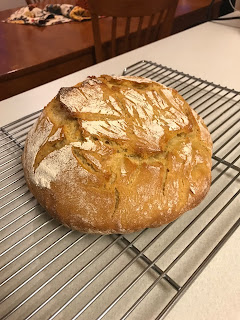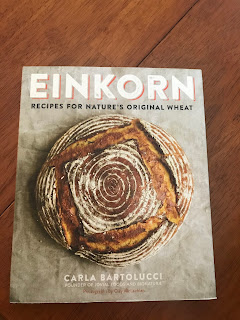“I’m about to introduce you to a miracle product…”
 |
| Einkorn bread: flour, water, and salt. |
I always
feel like when I talk about Einkorn that I am in some kind of an infomercial. Just so you know, I don’t own stocks in any
companies that sell einkorn, I don’t own a farm that grows einkorn (yet), I don’t
sell einkorn baked goods (yet), but it is something that has really helped my
family.
Shortly
after we got married, Myra started showing symptoms that were in the flu/cold
category. She was often fatigued,
congested, and got headaches. I was not
willing to believe that it was an allergy to me or that her frequent naps were
an avoidance strategy. So, we started
ruling things out.
A mold testing
kit proved that our trailer that we were living in was perhaps not the
healthiest environment for us. Her
symptoms could have been the result of black mold and maybe I wasn’t reacting
due to my years of allergy shots. We moved.
We carted all of our stuff the twenty feet into a newly refurbished apartment,
and somehow, the symptoms followed us.
Years
passed with no relief. Myra headed off
to grad school in Juneau where she ran into a fellow grad student who had
suffered from similar symptoms.
“I’m allergic
to gluten,” she explained to Myra. “I am
completely gluten free now, and I don’t have any more problems.”
While at
school, Myra changed diets with amazing results. She came home recharged and excited about her
discovery.
“So, I have
gone gluten free,” she exclaimed with excitement to me.
“Huh,” I
said pulling two fresh loaves of bread from the oven, “what exactly does that
mean?”
“Well, I
just can’t eat anything with gluten in it,” she responded.
“Like what?”
I asked as I began mixing up a batch of sourdough pancakes for the next
morning.
“Stuff with
wheat,” Myra said nonchalantly.
You know
what has wheat in it? Everything. Everything has wheat in it. Pasta, bread, cereal, flour tortillas, a lot
of processed foods (we didn’t eat many of those anyway), pretty much everything
we ate had some form of gluten in it. I
went into mourning.
We began
experimenting with gluten free products… some we just threw out and ate the box
instead since the packaging was more palatable.
We bought blends of gluten free flour (some are really good I have to
mention that in fairness) and it was like trying to make bread out of wallpaper
paste. Pie crusts fell apart and could
not be rolled without sticking to the rolling pin for eternity. Myra’s chocolate chip cookies (the best in
the world) were a thing of the past… that whole better to love and lost than
not to love at all idea… yeah, that’s dumb.
Gluten free
products have come a long way, and I have to admit, it is possible to make a
pretty decent pizza crust gluten free, but it still does not quite have the
right texture.
Then came
my binge watching of food documentaries on Netflix. I don’t recommend this unless you want to
completely change how you are eating. I
came across one entitled Sustainable that
focused on organic agriculture in contrast to our current factory farm
methods. One of the guys on there was
growing something called Einkorn and a Chicago based baker was using it to bake
breads that people who have gluten allergies could digest without suffering any
symptoms they did when they ate modern bread.
Einkorn is
considered an ancient wheat (quite possibly the bread Christ broke at the last
supper was made from Einkorn) and it has never been hybridized. Don’t confuse hybridization with Genetically
Modified. They are two different animals. We have Labrador retrieves due to hybridization
after all, and any duck hunter will tell you that is a good and natural thing.
Hybridization
in animals and plants is basic selective genetics. Plants and/or animals that have traits that are
preferred are allowed to reproduce. That
explains why labs have webbed feet and a water-repellent coat. Generations of dogs that demonstrated these
characteristics were bred to bring about future generations characterized by
those specific traits.
Genetically
modified organisms come from the lab. No
mood music is needed to bring about these altered offspring (sorry Barry
Manilow). Scientists inject information
at the genetic level from a fish into a tomato and bam, you have a tomato that
does not bruise in shipment. No offense
was meant to geneticists in the simplification of this process, but that is
enough of a gist for this blog.
So,
technically speaking, modern day wheat farmers are not modern day Prometheuses
(Prometheusi?) creating new life in a lab.
They are like horse breeders trying to produce the fastest horse through
selective breeding. In this case though,
wheat has been bred to be uniform, quick growing, bulk producing, easily
harvested grain.
A side result,
however, is that modern wheat is not as healthy of a food source as ancient
wheats like Einkorn. Modern wheat has a
lower protein content and a higher starch content (carbohydrates). According to Bartolucci, “Einkorn contains
roughly 30 percent more protein than modern wheat and more protein than any
other grain, while having 15 percent less starch…”
In case I
am starting to sound like Charlie Brown’s teacher to you, Einkorn is good for
you in comparison to modern wheat.
So, I
figured, if it is better for those with gluten allergies (everyone really) than
it must have less gluten. That thought
pattern is incorrect though. Anyone who
has baked with “regular” modern wheat understands that gluten is what sticks
the dough together. The longer einkorn
is kneaded, the stickier it becomes (aka develops gluten). It comes back to the protein though. The higher protein lower starch make-up of
the gluten is a more suitable food source for the human body to digest. Our bodies break down this protein better
than the starch in modern wheat.
I googled
sources of Einkorn flour and came across Jovial foods (I’ll put a link to their
website in resources section on the sidebar).
Jovial was started by a husband and wife team whose daughter was
allergic to gluten. She (Carla
Bartolucci) began experimenting with Einkorn, and her daughter’s symptoms went
away. I ordered enough flour to do a
little experimentation and a cook book.
 |
| We have pretty much loved everything we have tried from this book. |
This is the
only cook book that I have ever read and found myself getting emotional. Some may say that is reason enough to revoke
my man card, but I feel I still have enough credit on it to overcome a few
tears shed in reading about how Einkorn could possibly help my girls (Ellen
struggles from eczema which can be exacerbated by modern wheat).
I began the
week-long process of establishing a sourdough starter (fermented grains are
also thought to be more easily digested) so that I could bake bread. The flour, though when mixed with water is stickier than sin, is a joy
to bake with. It has a very fine texture
that feels incredibly smooth when worked.
The dough, when kneaded, becomes silky.
The first loaf I baked was made up of very few ingredients all of which
I could pronounce: flour, water, salt, and sourdough starter (fermented flour
with wild yeast activated in water).
I put it in
the oven and hoped it would be the answer.
Myra must have felt like a guinea pig as she took her first bite.
“So,” I
looked at her as though she would grow a second head, “how do you feel?”
“Fine,” she
said taking a second bite, “this is really good.”
Einkorn
lends a little bit of a nutty flavor to bread which is very pleasing.
“Any
symptoms?”
“Jason, I’ve
had two bites and it has been less than one minute,” she sighed.
“Okay, so I’ll
ask in another couple minutes,” this was a scientific study after all.
A couple
hours passed and no symptoms. Other
slices of bread, and Myra was not congested or fatigued. I made sourdough cinnamon rolls (the cookbook
has a recipe for the best cinnamon rolls I have ever eaten), chocolate cupcakes
(egg free and dairy free for our family), pancakes, pizza, and crackers (didn’t
even realize I could make those at home).
Each time Myra tasted something new, I would internally take note and
look for symptoms, but she felt fine, and the flavor was better than the modern
wheat recipes I used to make.
One of my
fears with going back to bread was that I would gain a bunch of the weight back
that I had recently lost, but the higher protein content and lower carbohydrate
content have meant that I have stayed exactly the same. My body must be getting more of what it needs
from this bread without all the junk it does not need.
We do still
eat gluten free foods. We have a gluten
free pancake recipe we like, I make gluten free cornbread, our spaghetti is
gluten free, but we finally have good bread back. There is a reason that Christ chose bread as
he drove home the message of the last supper, and I doubt it is just because he
had an extra loaf handy.
I am not a
doctor or a dietician. I won’t promise
you that Einkorn will work for you, and if you have been diagnosed with celiac
disease, I highly recommend you talk with your doctor before doing your own experimentation. I will say it was the answer for us. No more gluten allergies associated with bread,
and Ellen’s skin is clear. Baking is a
joy again.
 |
| What would we do without help in the kitchen? |
Bartolucci, Carla. Einkorn
Recipes For Nature’s Original Wheat. Clarkson Potter, 2015.
No comments:
Post a Comment